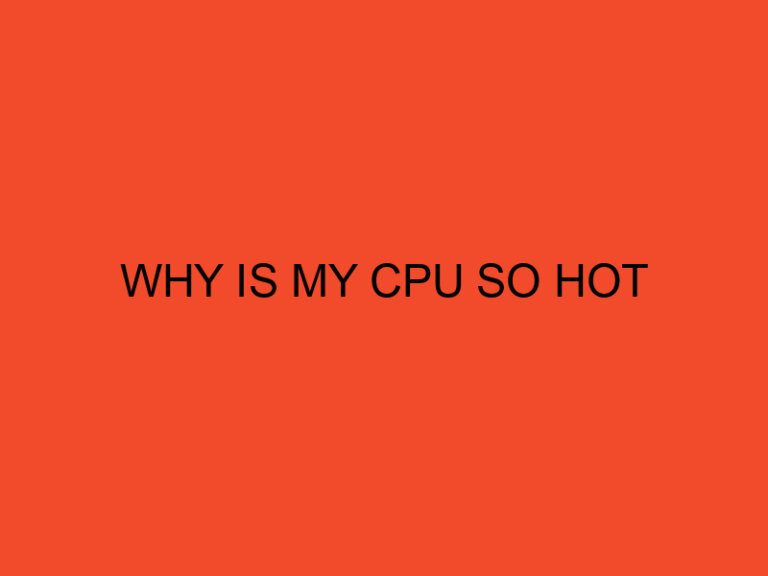When we talk about computer hardware, the CPU or Central Processing Unit is the primary component that comes to mind. It is often referred to as the brain of a computer, responsible for executing instructions and controlling the other components. But have you ever wondered what goes on inside a CPU? In this article, we will explore the components and functionality of a CPU in detail.
Table of Contents
What is the inside of a CPU?
Before we dive into the details, let’s first understand what a CPU is and why it is essential. A CPU is a small chip that is installed on the motherboard of a computer. It is responsible for carrying out all the instructions and calculations necessary to run the computer. Without a CPU, a computer would be unable to perform any tasks, and it would be no more than a box of wires.
What is a CPU?
A CPU is the primary component of a computer that performs all the logical and arithmetic operations. It is responsible for executing instructions and controlling the other components of a computer. The CPU is connected to other components through a set of buses, which allow data and instructions to be transferred between the components.
The Components of a CPU
A CPU is composed of several components that work together to perform calculations and execute instructions. These components include the Control Unit, Arithmetic Logic Unit, Registers, and Cache.
Control Unit (CU)
The Control Unit is responsible for controlling the flow of data and instructions within the CPU. It fetches instructions from memory, decodes them, and then sends them to the Arithmetic Logic Unit (ALU) to be executed.
Arithmetic Logic Unit (ALU)
The Arithmetic Logic Unit is responsible for performing arithmetic and logical operations, such as addition, subtraction, and comparison. It receives instructions from the Control Unit and performs the necessary calculations.
Registers
Registers are small, high-speed storage locations within the CPU that hold data and instructions temporarily. Registers are used to store the results of calculations, data for processing, and instructions that are currently being executed.
Cache
Cache is a type of high-speed memory that stores frequently used data and instructions. It is located within the CPU and is used to reduce the amount of time it takes to access data from the main memory.
How Does a CPU Work?
Now that we have a basic understanding of the components of a CPU let’s see how they work together to execute instructions. A CPU performs three main functions: Fetch, Decode, and Execute.
Fetch
The first step in executing an instruction is to fetch it from memory. The Control Unit sends a signal to the memory, requesting the instruction’s location. Once the instruction is located, it is fetched and brought into the CPU.
Decode
Once the instruction has been fetched, the Control Unit decodes it. The instruction is broken down into its individual components, and the Control Unit determines what operation needs to be performed.
Execute
Finally, the instruction is executed. The Control Unit sends the necessary signals to the ALU, telling it what operation to perform. The ALU performs the operation and sends the results back to the Control Unit.
Conclusion
In conclusion, the CPU is a crucial component of a computer that performs all the logical and arithmetic operations. It is made up of several components, including the Control Unit, Arithmetic Logic Unit, Registers, and Cache, which work together to execute instructions. The CPU fetches instructions from memory, decodes them, and then executes them using the ALU. Understanding how the CPU works can give us a better appreciation for the technology that powers our daily lives.
FAQs
What is the difference between a CPU and a GPU?
A CPU is designed to handle general-purpose tasks and perform a wide range of calculations, while a GPU is specialized for performing complex mathematical operations in parallel, making it ideal for graphics-intensive tasks like gaming and video rendering.
How does a CPU handle multitasking?
A CPU uses a technique called time-sharing to handle multiple tasks simultaneously. It switches between tasks quickly, giving the illusion of multitasking.
Can a CPU be upgraded?
Yes, CPUs can be upgraded by replacing the existing CPU with a more powerful one that is compatible with the motherboard.
What is overclocking?
Overclocking is the process of increasing the clock speed of a CPU to make it run faster than its original specification. This can lead to improved performance but also increases the risk of damage to the CPU.
What is the future of CPU technology?
The future of CPU technology is focused on increasing performance while reducing power consumption. This involves the use of advanced manufacturing processes, new materials, and innovative architectures to create more efficient and powerful CPUs.





